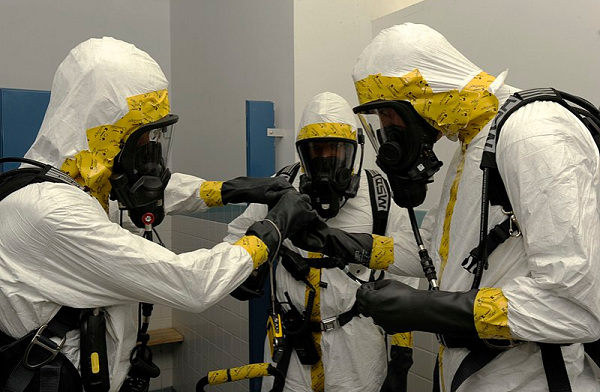As an Air Force Emergency Management (3E9X1) professional, your job is to respond to natural or man-made disasters.
Emergency Management professionals do not just respond to a natural or man-made disaster they can assist with preparation and prevention planning for disasters.
Emergency Management professionals never have two situations that are the same and that is why it is important that individuals are trained to know how to react and advise in all disaster scenarios.
Related Article: 20 Reasons to Join the Military (and 7 reasons not to)
Education
To get into the program you must have at minimum a High School Diploma or GED.
You must meet the minimum ASVAB requirements.
Requirements
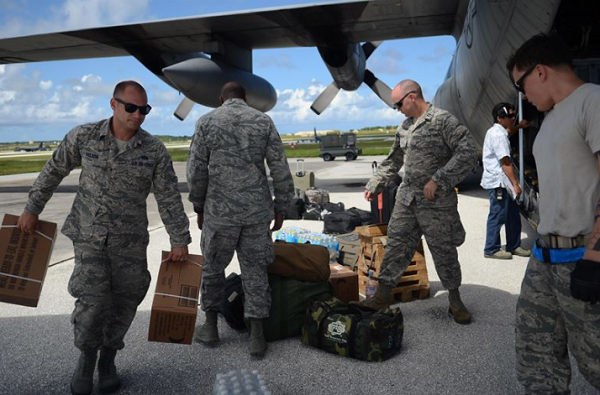
The ability to speak clearly is needed because you are in situations where your advice could mean clearance or evacuation of an uncontrolled situation.
As with other positions in the Air Force, normal color vision is required.
You cannot have a history of claustrophobia and must be between the ages of 17 and 39.
The background check may take any where from a few weeks to a few months because it is required to pass a National Agency Check, Local Agency Check and Credit Check.
There is a need to drive government vehicles, so a valid driver’s license is also required.
Training
All individuals will be required to complete 8.5 weeks Basic Training.
After completing the Basic Training, individuals can expect to spend anywhere from 67-500 days training at F.t Leonard Wood in Montana.
The number of days that you could be training varies based on the area you study.
What Does Being in Emergency Management Involve?
Being in Emergency Management involves being placed in a wide range of situations that you have likely never been in before.
While you may not be the individual who makes the decisions, your expert advice will be what the incident commander uses to make their decision on how to clean, evacuate or recover from an event.
As previously mentioned, you will not just be responding to incidents that have already happened.
Related Article – Air Force Command and Control Operations (1C3X1): Career Details
Your job also involves educating, training and planning for incidents that we know will be happening or for incidents that have the possibility of happening.
This could include creating presentations and giving classroom setting lectures as well as conducting checks to make sure that organizations have the necessary tools to be properly prepared.
Some events that you may have to respond to include:
- Natural Disasters
- Major Threats
- Chemical, Biological, Radiological, nuclear and high yield explosive attacks (CBRNE)
- Weapons of Mass Destruction
In these events you may be required to provide HAZMAT response.
You could also be in charge of coordinating logistics response of the mobilization of resources and personnel.
In the logistics response you could be assisting the incident commander with all coordination and communication between departments.
An Emergency Management professionals may be keeping track of data and mapping out diagrams of what the projected scenarios will be within certain time frames of an incident.
Individual in the Emergency Management position will organize meetings, locate individuals that are required to be in the meetings and keep meeting minutes.
After the completion of the meeting, it is also the responsibility of the Emergency Management professional to distribute the minutes and keep track of action items.
At times the position may require you to check equipment for stability, update tracking logs on equipment or inform incident commanders of equipment locations.
In addition to all of the coordination that Emergency Management professionals are responsible for, they must also go into a situation and identify and detect the hazard.
This can require suiting up with the correct PPE (Personal Protection Equipment), and analyzing every aspect of the unknown scenario and then giving your advice to the incident commander.
The Emergency Management professional will use a variety of tools in combination with knowledge learned during training to identify the hazard.
In this position you may go to any location all over the world and it is not considered a position that you are home every night.
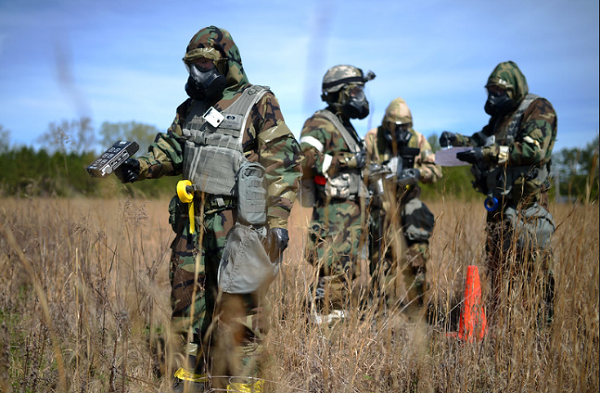
What does an Emergency Management Airman make?
The basic pay for all individuals in the Air Force is the same based on rank and time of service.
As with any other Air Force position, you receive base pay as well as many other benefits.
The table for the base pay is below.
| Insignia | Pay Grade | Rank | Abbreviation | 2023 Minimum Monthly Pay |
|---|---|---|---|---|
| E-1 +4 months | Airman Basic | AB | $1,917.60 | |
| E-2 | Airman | Amn | $2,149.20 | |
| E-3 | Airman First Class | A1C | $2,259.90 | |
| E-4 | Senior Airman | SrA | $2,503.50 | |
| E-5 | Staff Sergeant | SSgt | $2,730.30 | |
| E-6 | Technical Sergeant | TSgt | $2,980.50 | |
| E-7 | Master Sergeant | MSgt | $3,445.80 | |
| E-8 | Senior Master Sergeant | SMSgt | $4,957.20 | |
| E-9 | Chief Master Sergeant | CMSgt | $6,055.50 | |
| E-9 | Command Chief Master Sergeant | CCM | $6,055.50 | |
| E-9 | Chief Master Sergeant Of The Air Force | CMSAF | $6,055.50 |
Benefits
The benefits that the Air Force offers include housing and food support.
If you choose to live on base you will receive free housing including covered utilities and a food allowance for single airman.
If you choose to live off the base, you will receive a housing allowance that is based on rank, family status and location.
Related Article – Basic Allowance For Housing (BAH) Calculator
The Air Force provides free/low cost medical and dental in addition to offering a very low cost life-insurance policy.
As an Airman you will receive paid sick time plus 30 days paid vacation a year.
Individuals can take advantage of open space on an Air Force aircraft to travel internationally and receive lower rates on hotels near bases.
Having a retirement plan is something that you may not think about until you start to get closer to retirement age.
The Air Force offers a retirement program that allows you to retire after 20 years of service.
You will begin receiving benefits on the day you retire, all without any money being removed from your paycheck.
This generous retirement program is there for all individuals and helps make the planning easy for you.
Receiving education assistance is also a benefit of joining the Air Force.
The Air Force is very supportive of continued education.
As soon as you enter into Basic Training you are considered enrolled in Community College of the Air Force and you begin earning college credits.
You can receive tuition assistance, up to 100% coverage, with the Air Force Tuition Assistance Program, Post 9/11 GI Bill or the Montgomery GI Bill.
Job Reviews
Overall when reading reviews on the Air Force Emergency Management professional position, people are very satisfied with their decision.
They generally put that they would recommend the position and have a positive outlook.
With any military position, it is what you make it.
Related Article – Air Force Intelligence Officer: Career Details
If you get into a path that you like and you work hard at that position, you will find success.
A few negative comments that were repeated were the sometimes long hours and multiple deployments based on demand for their specialty.
Here are a couple reviews from people in the Emergency Management position:
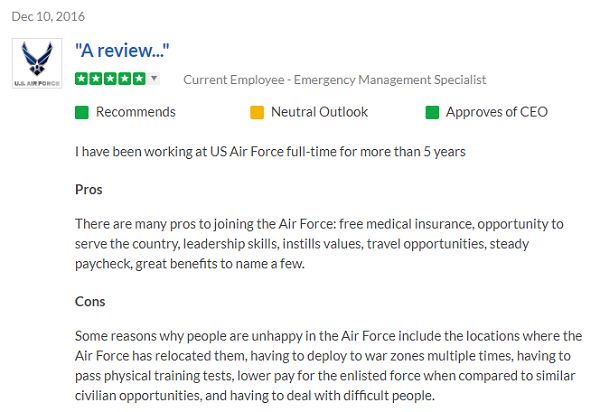
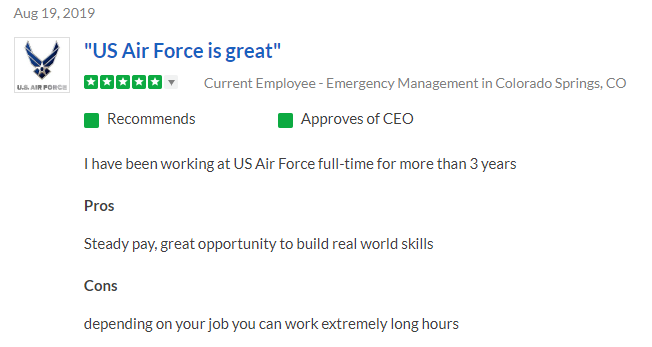
Civilian Career Opportunities
The skills that you learn in the Air Force Emergency Management position will directly relate to several different civilian career opportunities.
There are Emergency Response positions available at local, state and government levels.
You could work at the state level for the Department of Ecology completing Emergency Response for the varying emergencies you receive.
There is also the option of working for local city or counties as an Emergency Preparedness Coordinator or for organizations such as FEMA.
The skills that you learn with logistics and equipment will allow you to work in a variety of different government jobs.
Some job titles that the skills you will learn directly correlate with include:
- Emergency Logistics Coordinator
- Assessment and Exercise Program Supervisor
- Emergency Preparedness Coordinator
- Emergency Management Coordinator
- Emergency Response Specialist
Summary
Air Force Emergency Management professionals are responsible for preparing and responding to natural and man-made events.
Their responsibilities include developing emergency response plans and identifying/recovering a variety of hazards including weapons on mass destruction.
The position requires going to Basic Training for 8.5 weeks and then completing technical training at Ft. Leonard Wood.
You will receive many benefits as an Airman including free/low cost insurance, vacation, retirement and housing assistance.
People who are currently or have previously been, in that position are very happy with their decision.
The position allows you to gain skills and experience that directly relates to a variety of different civilian jobs.
References:
Air Force Emergency Management
- 5 Worst Jobs in the Air Force - June 20, 2024
- 4 Steps For Visiting An Air Force Recruiter Near You - June 19, 2024
- Air Force Safety Specialist (1S0X1) - June 19, 2024

